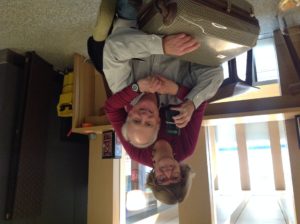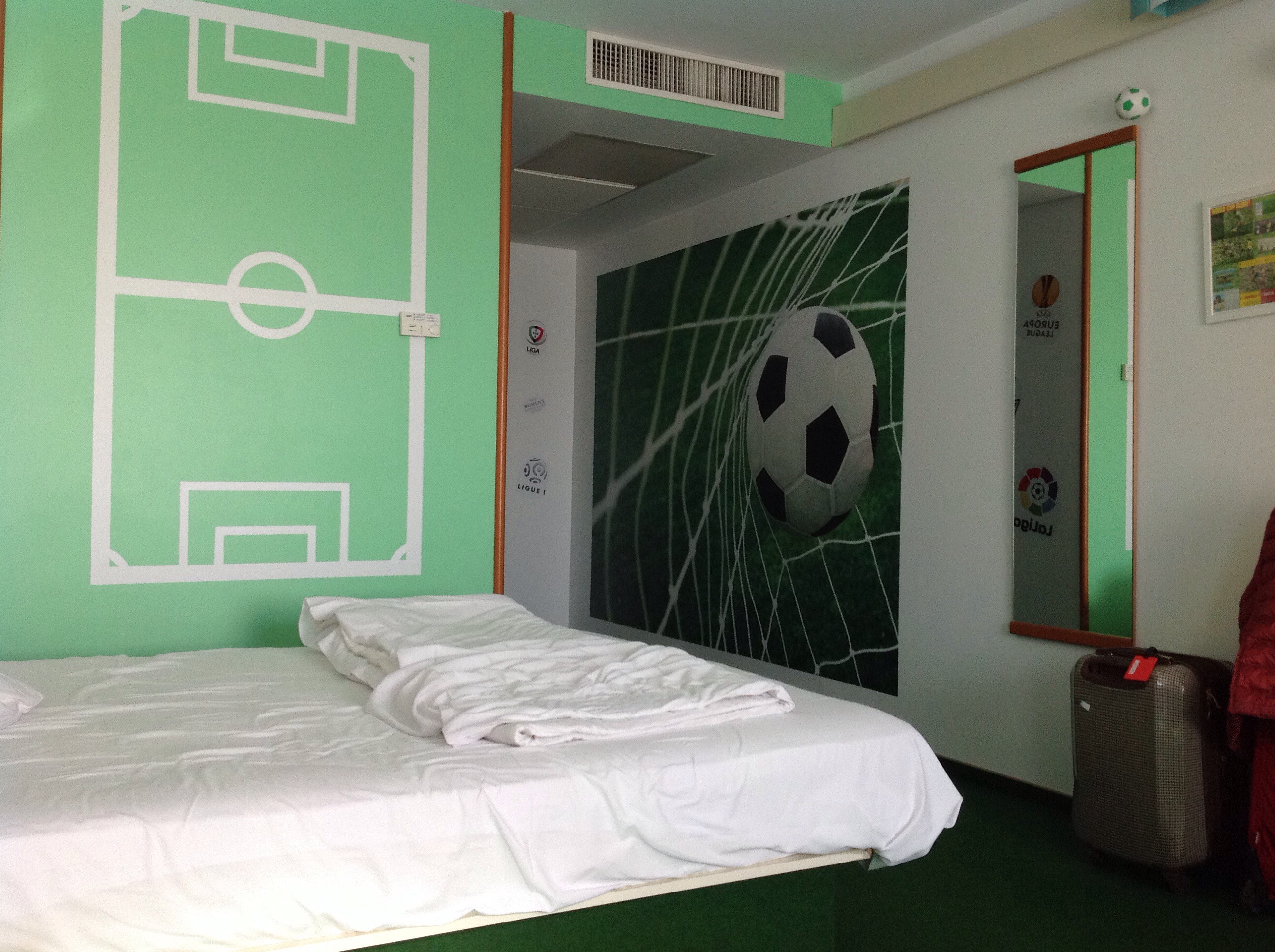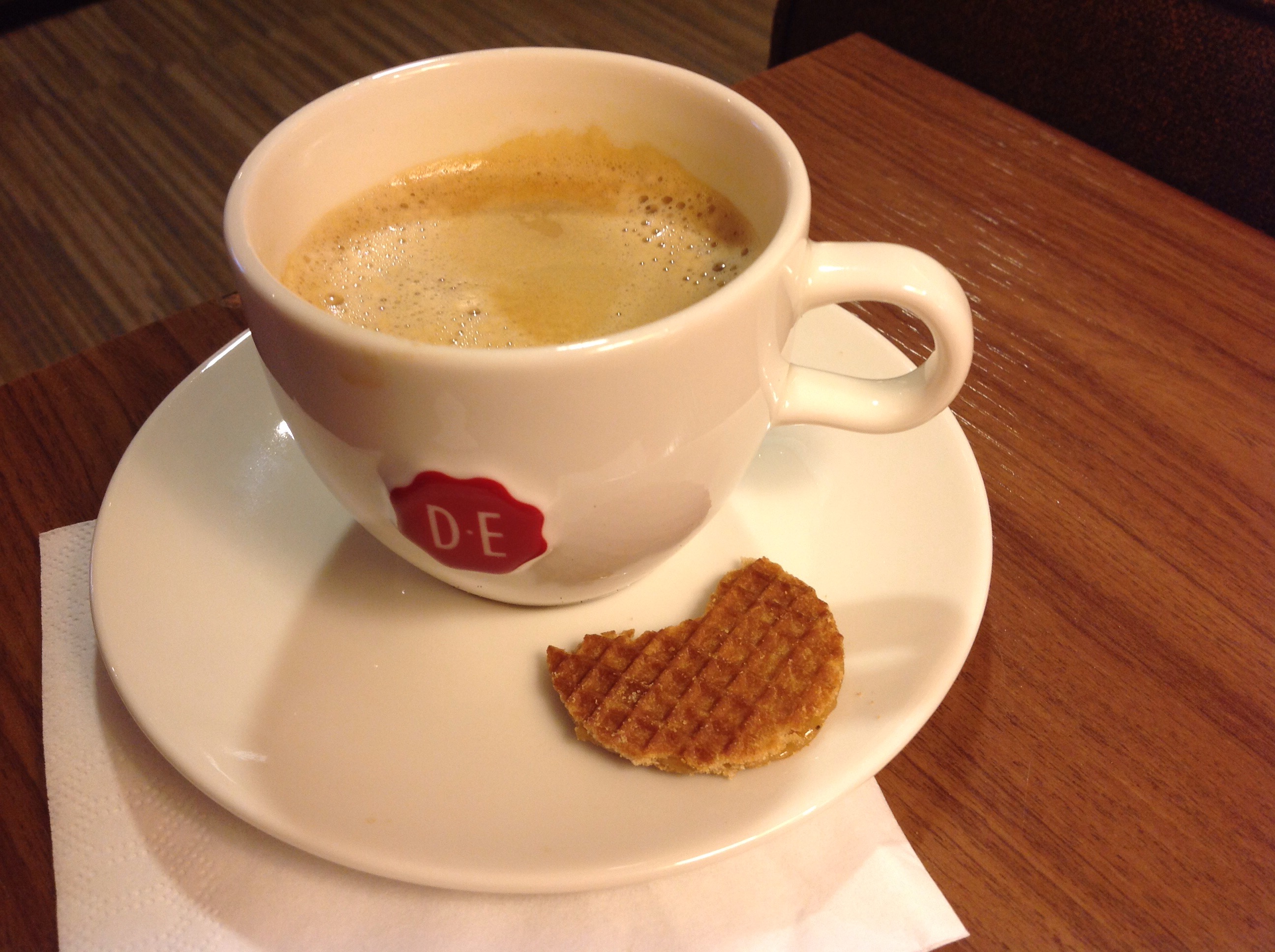…to my first-ever Football Bedroom. I just can’t resist posting one more picture, as we get ready to leave for the airport and head home. How can this not put a smile on your face?
Category: Ukraine to Romania (2018)
Bucharest, Romania
I seem to have missed a couple of days, but we just haven’t had much downtime. Trying to maximize the last few days of the trip, I guess.
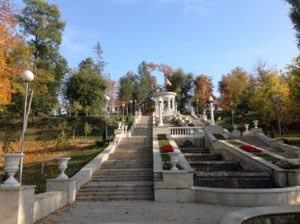
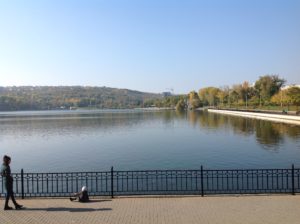 Since I last wrote, we spent a couple of days in Chisinau, the capital of Moldova. It was charming, a city of scenic avenues and parks. This particular park/staircase was built to honour Leonid Brezhnev’s daughter because she went to school there, and they added a man-made lake — dug by students with simple shovels! — so there would be an attractive vista below the steps. Rather Marie-Antoinette-ish, I think.
Since I last wrote, we spent a couple of days in Chisinau, the capital of Moldova. It was charming, a city of scenic avenues and parks. This particular park/staircase was built to honour Leonid Brezhnev’s daughter because she went to school there, and they added a man-made lake — dug by students with simple shovels! — so there would be an attractive vista below the steps. Rather Marie-Antoinette-ish, I think.
Then on Tuesday we came by bus — pretty much an all-day drive — from Chisinau to Bucharest. It felt good to be crossing our last border, as we entered Romania. Although we did not ever have any problems, except for our suitcases being searched once for large-quantity-cigarette-smuggling, we had been warned about possible shake-downs of American-looking tourists when going into or out of Transnistria, and advised to hide our money in different pockets etc. So it was nice to get into the final country on this trip, without having to worry about losing our beer budget.
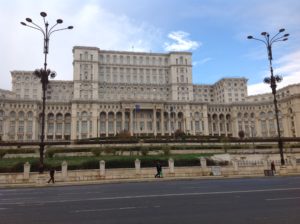 Our first visit in Bucharest was to the Parliament building, which is absolutely humungous, we could not believe it. I will post a picture of the outside here, that really does not do it justice. You should also note is a perfectly square building, so it is as deep as it is wide. Geoff says he saw bigger ones in North Korea but, honestly, it may be the biggest building I have ever seen in my life.
Our first visit in Bucharest was to the Parliament building, which is absolutely humungous, we could not believe it. I will post a picture of the outside here, that really does not do it justice. You should also note is a perfectly square building, so it is as deep as it is wide. Geoff says he saw bigger ones in North Korea but, honestly, it may be the biggest building I have ever seen in my life.
 And here is a picture taken from the presidential balcony. Ceausescu planned it, and the enormous plaza and wide avenue below, in order to make great speeches to one million plus people, but because he was overthrown before the building was completed, he never got to make a speech from there as planned. But ONE person did, and it was… tah-DAH!… Michael Jackson. He was in Bucharest (not Budapest!) for a concert, toured the Parliament, and when they took him out on the balcony his fans were massed below and started cheering him. So he waved and said to them “Hello Budapest, thank you so much, I love you all!” Yes, he said Budapest, not Bucharest. Ceaucescu was probably rolling around in his grave.
And here is a picture taken from the presidential balcony. Ceausescu planned it, and the enormous plaza and wide avenue below, in order to make great speeches to one million plus people, but because he was overthrown before the building was completed, he never got to make a speech from there as planned. But ONE person did, and it was… tah-DAH!… Michael Jackson. He was in Bucharest (not Budapest!) for a concert, toured the Parliament, and when they took him out on the balcony his fans were massed below and started cheering him. So he waved and said to them “Hello Budapest, thank you so much, I love you all!” Yes, he said Budapest, not Bucharest. Ceaucescu was probably rolling around in his grave.
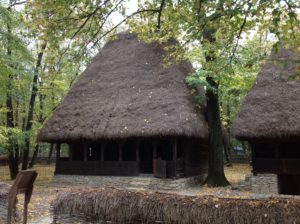 Yesterday we visited a very large park, where they had brought in actual houses from all the regions of Romania. Very interesting indeed, seeing the different styles of construction, to suit different climates and lifestyles. I will just post one here to give you a little flavor.
Yesterday we visited a very large park, where they had brought in actual houses from all the regions of Romania. Very interesting indeed, seeing the different styles of construction, to suit different climates and lifestyles. I will just post one here to give you a little flavor.
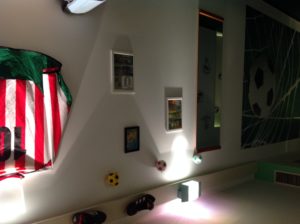 Last night we checked into the final hotel on our itinerary, and our room is certainly unusual. A football theme, the like of which I have never seen before.
Last night we checked into the final hotel on our itinerary, and our room is certainly unusual. A football theme, the like of which I have never seen before.
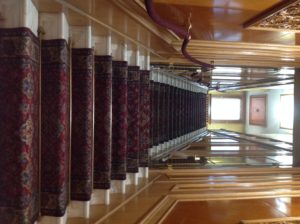 And today, Nicolai Ceausescu’s residence. Pretty fancy digs for a guy who was one of nine children of an impoverished Shoemaker. Always thought-provoking when one sees how supposedly Socialist dictators tended to live, while the common people went hungry. These are the steps down to the spa in his 170-room house. The whole place is completely over the top!
And today, Nicolai Ceausescu’s residence. Pretty fancy digs for a guy who was one of nine children of an impoverished Shoemaker. Always thought-provoking when one sees how supposedly Socialist dictators tended to live, while the common people went hungry. These are the steps down to the spa in his 170-room house. The whole place is completely over the top!
The Republic of Transnistria
We are now in an interesting place: Transnistria. The UN and international community do not consider it to be a country, but rather part of Moldova. The Transnistrians, however, do not agree. They have their own currency, postal system, legislature… and border control. Which meant that crossing the border to get here was a little complex. We came by car from Ukraine to the border, at a short bridge across a river. First the Ukrainian border post, where we had exit stamps put in our passports, then another 20 feet to the Moldovan border post, where they stamped a passport entry. Then we crossed the little bridge, and on the other side was the Transnistria border post. Just as official-looking as any border you might cross anywhere, with customs and immigration staff, and border guards. They asked the same types of questions about why we were visiting, how long would we stay, what hotel we would be in, and then — not being allowed to stamp passports under international laws — they issued us each a paper visa for our two-day stay here.
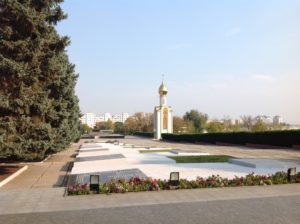 We are staying in the capital, Tiraspol, a charming small city with very friendly people. Spent our day walking and sightseeing, visiting a museum of local history, and enjoying a glass of local wine.
We are staying in the capital, Tiraspol, a charming small city with very friendly people. Spent our day walking and sightseeing, visiting a museum of local history, and enjoying a glass of local wine.  I will just post a couple of pictures, to show two attractive vistas in the centre of town.
I will just post a couple of pictures, to show two attractive vistas in the centre of town.
Tomorrow we head onward to “the rest of Moldova” by bus. We are now at the halfway point of the travels — and from experience we know that the rest of the trip is likely to fly by. Ah, well…..
Chernobyl Photos
Sorry these missed the last posting, but I had to wait for WiFi To upload pictures…. I hope the captions and pics line up enough for you to figure out what goes with what. Still struggling a little with my iPad!
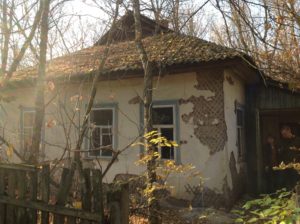 1) The doctor’s house, just inside the 30-kilometre zone “outer fence” of the restricted site.
1) The doctor’s house, just inside the 30-kilometre zone “outer fence” of the restricted site.

2) The nuclear reactor, encased in its sarcophagus.
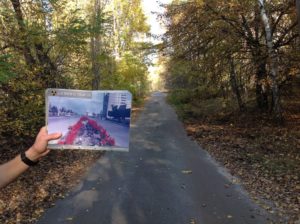
3) We are standing on the right lane of the boulevard in the photo, in exactly the same spot. Nature is taking over!
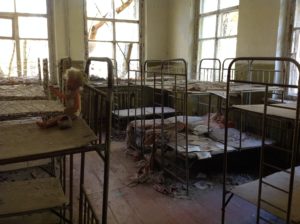
4) The primary school, nap-time cots.
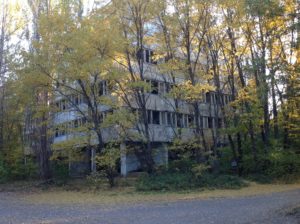
5) Apartment building, very typical for the town. “No Entry!”
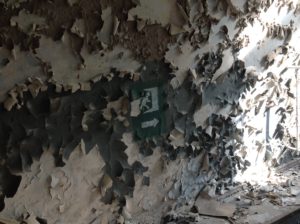 6) Look closely and you will see the “Emergency Exit” sign in the middle of this age-blistered wall. Sadly ironic!
6) Look closely and you will see the “Emergency Exit” sign in the middle of this age-blistered wall. Sadly ironic!
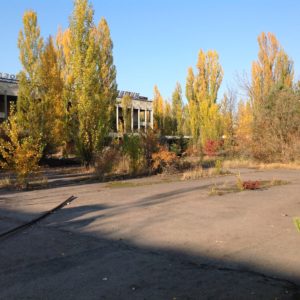 7) This is the town centre, formerly a large open plaza.
7) This is the town centre, formerly a large open plaza.
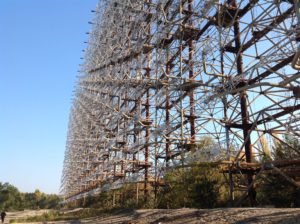
8) The Duga, about 20 km away from the reactor. Subject of a fascinating, but admittedly conspiracy-theory, movie we saw at Hot Docs: “The Russian Woodpecker”.
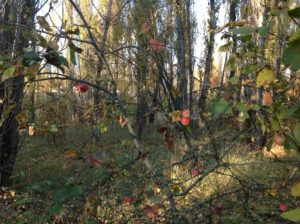 9). We felt like Adam and Eve. “Forbidden Fruit”
9). We felt like Adam and Eve. “Forbidden Fruit”
Chernobyl
What an interesting day yesterday. A trip to Chernobyl and associated sites. I had thought it might be “gimmicky” somehow, based on how it tends to be advertised, but it turned out to be an excellent and informative tour. Just by coincidence, 4 nuclear engineers were on the trip with us, so we didn’t worry about the radiation levels because they obviously didn’t. On a side note, their being there made me realize how very integrated Europe is now — they were respectively a Finn, 2 Swedes, a Slovak, and had worked together in the past at a site, I think in Sweden, and a friend/former colleague had just moved to work at Chernobyl so they were now all visiting the Ukraine. But I digress….
On the way to the site our guide gave us a detailed overview of the accident, and safety briefing, including a long list of dos and and don’ts. Which included no straying from paths, no entering buildings except for a very few specific ones that had been decontaminated, don’t touch things or pick anything up, don’t pat any dogs or cats you might see, don’t sit down on any walls or benches, don’t put purses or backpacks on the ground, don’t eat any food you may see growing (mushrooms, apples), and so on. We had already been warned by the tour company that we had to wear long pants, long sleeves, hats, socks, and closed-toe shoes. Personal Geiger counters were available as well.
There was top security around access as well. We had had to provide passport info before leaving Canada, and our passports were checked to a list by guards as we entered and exited what they call the 30-kilometre zone and the 10-kilometre zone. We also had to pass through personal radiation detectors, rather similar in look and size to those airport body scanners, at three separate sites as we toured inside the 10-kilometre zone. Our mini-bus was also checked for radiation levels at various checkpoints.
When we got to the town of Pripyat, where the Chernobyl reactors are, it was like walking through a ghost town. Apartment buildings, public buildings, a theatre, a sports stadium, a school, all in various stages of deterioration and showing signs of being abandoned in a hurry. We were always walking through forest, looking at these buildings among the trees, and as we walked more and were shown before-and-after pictures in various places, we realized that nature was just taking back what had been a treeless town 32 years ago.
We also learned that the nuclear reactor called Chernobyl was originally named after Lenin but, after the accident, the USSR did not want his name associated with it and they quickly renamed the reactor after the local area.
The on-site radiation was explained to us in some detail, and the tour guide did pay close attention to this during our time in the zone. We were surprised that some of the radiation was extremely localized, for example a whole school building shell might be very low radiation, but the tour guide was able to show us a tiny spot, just a few inches, where the Geiger counter went “off the map”, and this was because when the site was decontaminated somebody missed a tiny bit, the same way you sometimes miss a teeny tiny muddy area when you wash your car. We also saw, from a safe distance, the local hospital where, right after the disaster, the clothes of about 30 firefighters who were first on the scene when the reactor blew were piled in the basement. The basement was subsequently filled to bury the clothes in concrete and sand, but 32 years later those buried clothes are highly, highly radioactive.
We were surprised to learn that the nuclear site has not been abandoned, as we had assumed. The reactor that blew up is completely encased in a “sarcophagus” but there are three other reactors, all now being decommissioned. About 500 engineers and nuclear workers, from all over Europe, are involved. They are bused in every day from outside the 10 km zone, and because of the radiation exposure each of them can only work 15 days on the site. They estimate everything will be completed by 2029.
We were staggered by the huge loss of life associated with trying to contain and decontaminate the site, immediately at the time of the disaster and then subsequently over several years. It’s hard to find words to comment on the scope of the disaster.
I will post pictures from our tour, but you may see them tomorrow as I have bad bandwidth at present. Hope everyone is having a good day!
Touring in Kiev
We arrived yesterday mid-afternoon, didn’t have a lot of energy because we had only slept maybe three hours during our travels the night before, but we managed to do a neighbourhood stroll to orient ourselves to the central town, and to enjoy a bowl of delicious borscht, served here with black bread and thin slices of lard (Geoff ate mine – as cold lard is not for the faint of heart!). Then today, we met a guide and did a walking tour.
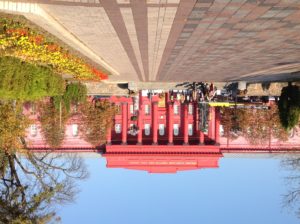 This colourful and beautiful building is part of the University here.
This colourful and beautiful building is part of the University here.
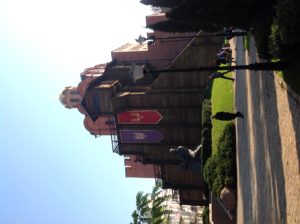 And here is a 1998 reconstruction of the former main gate of the old fortified city. Impressive!
And here is a 1998 reconstruction of the former main gate of the old fortified city. Impressive!
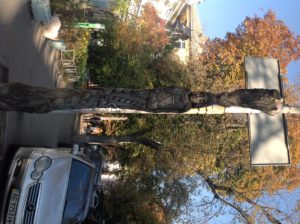 The street art is very interesting. This is a carving, from a dead street-tree, which portrays a Scythian goddess. It was done by an anonymous artist, no-one has ever stepped forward and taken credit!
The street art is very interesting. This is a carving, from a dead street-tree, which portrays a Scythian goddess. It was done by an anonymous artist, no-one has ever stepped forward and taken credit!
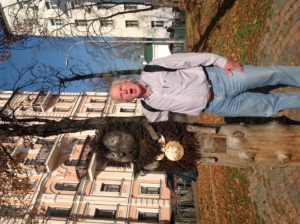 And next, a character from a Russian kids’ cartoon, “Hedgehog in the Fog”, with his new friend Geoff. Quite a marked resemblance, don’t you think?
And next, a character from a Russian kids’ cartoon, “Hedgehog in the Fog”, with his new friend Geoff. Quite a marked resemblance, don’t you think?
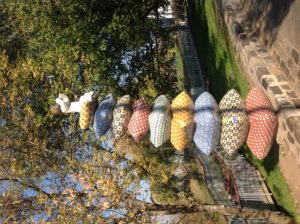 And this wonderful sculpture/statue, I am honestly not sure what to call it, is just one striking piece in a park that contains many such mosaic sculptures. Really unusual and very pretty.
And this wonderful sculpture/statue, I am honestly not sure what to call it, is just one striking piece in a park that contains many such mosaic sculptures. Really unusual and very pretty.
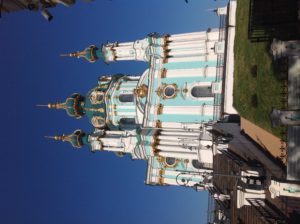 This one is for our friends Andrey T. and Andrej K., and my brother Andrew, because it is the church of St Andrew. It was built by Catherine the Great because when she came to Kiev, there was no private royal chapel, and she did not want to worship amongst the hoi-polloi. It is the only church in Kiev without bells because, of course, nobody needed to call anyone else to come to service.
This one is for our friends Andrey T. and Andrej K., and my brother Andrew, because it is the church of St Andrew. It was built by Catherine the Great because when she came to Kiev, there was no private royal chapel, and she did not want to worship amongst the hoi-polloi. It is the only church in Kiev without bells because, of course, nobody needed to call anyone else to come to service.
I think that finishes the update for today. Tomorrow morning early we set off for a day tour to Chernobyl. I will provide an update in due course.
Hope everyone is having a great week!
Amsterdam Stopover
Ready for the Road Again!
Getting ready for our next adventure…. from Toronto to Kiev via Amsterdam, then on to Transnistria, Moldova, and Romania.
And we have a side trip to Chernobyl. Here we are with Geoff’s Geiger counter. Not sure how robust this piece of technology is. Stay tuned! 🙂
